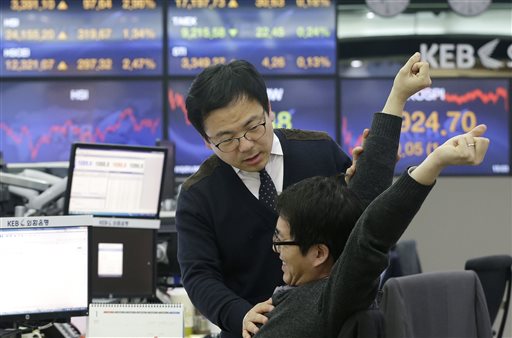
A currency trader stretches while working at the foreign exchange dealing room of the Korea Exchange Bank headquarters in Seoul, South Korea on Jan. 9, 2015. Energy stocks took a hit in Asian trade Tuesday, Jan. 13, as oil prices fell toward six-year lows, with warnings of further volatility ahead, but some rare upbeat Chinese trade data boosted Hong Kong and Shanghai. AP PHOTO/AHN YOUNG-JOON
HONG KONG–Energy stocks took a hit in Asian trade Tuesday as oil prices fell toward six-year lows, with warnings of further volatility ahead, but some rare upbeat Chinese trade data boosted Hong Kong and Shanghai.
Crude was dealt another blow Tuesday when key OPEC member the United Arab Emirates said the cartel could not stop world prices plunging and called for a cut in US shale oil output.
Tokyo fell 0.64 percent, or 110.02 points, to finish at 17,087.71, although it pared initial losses as the yen weakened in afternoon trade.
Sydney fell 0.33 percent, or 18.01 points, to 5,404.7 and Seoul closed 0.20 percent lower, giving back 3.81 points to 1,917.14.
However, Hong Kong added 0.79 percent, or 189.51 points, to 24,215.97 and Shanghai rose 0.19 percent, or 5.98 points, to 3,235.30.
Crude sank again Monday after Wall Street investment titan Goldman Sachs slashed its price outlook for the commodity, adding to anxiety about a global oversupply, weak demand and soft growth in the key Chinese and European markets.
The warning sent US shares tumbling, with the Dow down 0.54 percent, the S&P 500 off 0.81 percent and the Nasdaq tumbling 0.84 percent.
“There is no escaping crude’s effect on global markets,” Evan Lucas, a markets strategist in Melbourne at IG Ltd., said, according to Bloomberg News. “This will see first-half volatility ramping up throughout the globe.”
‘First-half volatility’
Prices continued their descent Tuesday, after a mauling in the previous session.
Brent crude for February delivery fell $1.93 to $45.50 a barrel–around its lowest point since April 2009. On Monday it had plunged more than five percent to end below $50.
US benchmark West Texas Intermediate shed $1.55 cents to $44.52–its weakest levels since March 2009–a day after losing 4.7 percent.
Selling pressure increased when UAE Energy Minister Suhail al-Mazrouei told the Gulf Intelligence UAE Energy Forum in Abu Dhabi: “We cannot continue to be protecting a certain price.
“We have seen the oversupply, coming primarily from shale oil, and that needed to be corrected.”
Prices have been falling since June but the pace of the slide accelerated in November when the Organization of the Petroleum Exporting Countries (OPEC) decided to maintain its output.
That came as a huge supply of newly tapped oil from the US has come online.
The weakness filtered through to Asian energy companies. In Sydney BHP Billiton ended down 1.89 percent and Woodside Petroleum fell 1.73 percent by the close, while CNOOC in Hong Kong was 1.69 percent lower.
Tokyo-listed Inpex shed 2.59 percent and Showa Shell gave up 2.76 percent.
Shanghai and Hong Kong reversed initial losses following the release of Chinese trade figures.
The General Administration of Customs said exports rose 9.7 percent year on year in December, while imports fell 2.4 percent. That resulted in an almost doubling of the country’s trade surplus during the month.
The export figure exceeded the median forecast of six percent by 40 economists in a Bloomberg survey, while the fall in imports was less severe than their prediction of a 6.2 percent decline.
On currency markets the yen eased against the euro and dollar after a morning rally dissipated.
The dollar fetched 118.33 yen compared to 118.27 yen in New York, while the euro was at 140.05 yen against 139.98 yen.
The single currency also bought $1.1836, compared with $1.1834 in US trade.
Gold was $1,238.84 an ounce, compared with $1,222.03 on Friday.
In other markets:
— Mumbai declined marginally by 0.58 percent, or 159.54 point, to end at 27,425.73
Oil and Natural Gas Corporation fell 2.37 percent to 339.65 rupees while automaker Mahindra and Mahindra rose 1.25 percent to 1,246.75 rupees.
— Bangkok rose 0.25 percent, or 3.76 points, to 1,534.97.
Bank of Ayudhya soared 7.21 percent to 59.50 baht, while hotels operator Minor International gained 3.15 percent to 32.75 baht.
— Malaysia’s main stock index rose 0.80 percent, or 13.82 points, to end at 1,748.90.
CIMB Group jumped 14.29 percent to close at 5.92 ringgit following reports its planned banking merger with RHB Capital would be scrapped. RHB gained 0.91 percent, ending at 7.80 ringgit.
— Singapore closed down 0.11 percent, or 3.82 points, to 3,341.07.
United Overseas Bank fell 0.51 percent to Sg$23.36 while Singapore Telecom finished down 0.26 percent at Sg$3.89.
— Jakarta closed up 0.51 percent, or 26.43 points, to 5,214.36.
Palm oil producer Astra Agro Lestari Tbk rose 0.39 percent to 25,900 rupiah, while cigarette maker Gudang Garam Tbk fell 0.17 percent to 60,000 rupiah.
— Taipei rose 0.58 percent, or 53.5 points, to 9,231.8.
Taiwan Semiconductor Manufacturing Co. was 0.38 percent higher at Tw$132.5 while Hon Hai Precision Industry added 0.7 percent to Tw$86.3.
— Wellington added 0.48 percent, or 26.80 points, to 5,636.61.
Air New Zealand was up 0.77 percent at NZ$2.62 and Spark lifted 0.47 percent to NZ$3.175.
— Manila closed 0.55 percent higher, adding 40.64 points to 7,399.00.
Ayala Land rose 0.44 percent to 34.15 pesos, Manila Electric added 0.46 percent to 263.00 pesos and Philippine Long Distance Telephone gained 0.81 percent to 2,970 pesos.